Small schools face a unique challenge: students deserve the same quality recognition as their peers at larger, better-funded institutions, yet budgets rarely stretch to accommodate expensive recognition systems. Whether you’re a K-8 elementary school, a rural district with limited resources, a charter school operating lean, or a private institution watching every dollar, the question remains the same—how do we celebrate student achievements without compromising our financial stability?
The good news? Affordable hall of fame solutions exist that deliver professional results without requiring tens of thousands of dollars. Modern digital recognition technology has become increasingly accessible, with options specifically designed for schools operating on tight budgets. This comprehensive guide explores cost-effective strategies, creative alternatives, and practical implementation approaches that make quality recognition achievable for schools of any size or budget level.
Understanding the Recognition Gap for Small Schools
Before exploring solutions, it’s important to understand why small schools often struggle with recognition infrastructure and why this gap matters more than many administrators realize.
Why Small Schools Need Recognition Even More
Smaller enrollment doesn’t mean students accomplish less or deserve less recognition. In fact, small schools often benefit MORE from comprehensive recognition programs:
Community Identity Building: In small schools where everyone knows everyone, public recognition strengthens community bonds and creates shared pride in collective achievements.
Student Motivation: With fewer students, each individual’s accomplishments carry more weight. Visible recognition motivates students to pursue excellence knowing their efforts will be acknowledged.
Retention and Recruitment: Small schools compete with larger institutions for enrollment. Professional recognition systems demonstrate institutional quality and commitment to celebrating student success.
Multi-Sport and Multi-Activity Participation: Small schools often have students participating in multiple activities. Recognition systems need capacity to celebrate diverse achievements across all programs.

Budget Constraints That Limit Recognition
Small schools typically face specific financial challenges that make traditional recognition approaches difficult:
Limited Capital Budgets: Annual capital improvement budgets may be $10,000-$25,000 or less, covering all facility needs—not just recognition displays.
Competing Priorities: Recognition competes with curriculum materials, technology infrastructure, facility maintenance, and other essential needs.
No Dedicated Recognition Budget: Unlike larger schools with separate athletic or activities budgets, small schools often fund recognition from general operating budgets.
Grant Limitations: Many education grants restrict spending to academic programs, excluding recognition and celebration infrastructure.
Volunteer Dependency: Small schools rely heavily on volunteers for non-academic functions, including recognition program management, limiting complexity of systems they can maintain.
Understanding these constraints helps identify solutions that work within small school realities rather than assuming larger institution approaches can simply scale down.
Cost-Effective Digital Recognition Solutions
Modern technology has made professional recognition displays accessible at price points small schools can afford. Let’s explore specific options arranged by budget level.
Entry-Level Digital Solutions ($2,000-$5,000)
Schools working with very limited budgets can still implement functional digital recognition using smart technology choices:
Basic Smart TV Approach
The most affordable digital recognition uses consumer-grade smart TVs paired with simple presentation software:
- 55-inch smart TV: $400-$800
- Wall mount and installation: $100-$200
- Presentation software (Google Slides, PowerPoint): $0-$150/year
- Computing device (Chromecast, Fire Stick, or basic PC): $50-$300
- Total investment: $550-$1,450
This approach works well for schools with basic recognition needs—displaying rotating achievement slides, honor roll lists, or photo galleries. While not interactive, it provides professional-looking digital recognition at minimal cost.
Implementation Tips for Maximum Value:
Create standardized slide templates using free tools like Canva for consistent branding. Schedule automatic content rotation using built-in smart TV features or basic computing devices. Update content monthly or quarterly rather than attempting real-time updates requiring more sophisticated systems. Train multiple staff members on simple update processes ensuring sustainability.
Digital Signage Subscription Services
Cloud-based digital signage platforms provide more sophisticated features than basic slideshow approaches:
- 43-55 inch commercial display: $600-$1,200
- Computing stick: $100-$200
- Digital signage subscription: $15-$40/month ($180-$480/year)
- Mount and installation: $100-$200
- Total first-year investment: $980-$2,080
Platforms like ScreenCloud, Raydiant, or Rise Vision offer affordable plans specifically for schools, providing content management systems, scheduling capabilities, and professional templates that elevate presentation quality significantly beyond basic slideshows.
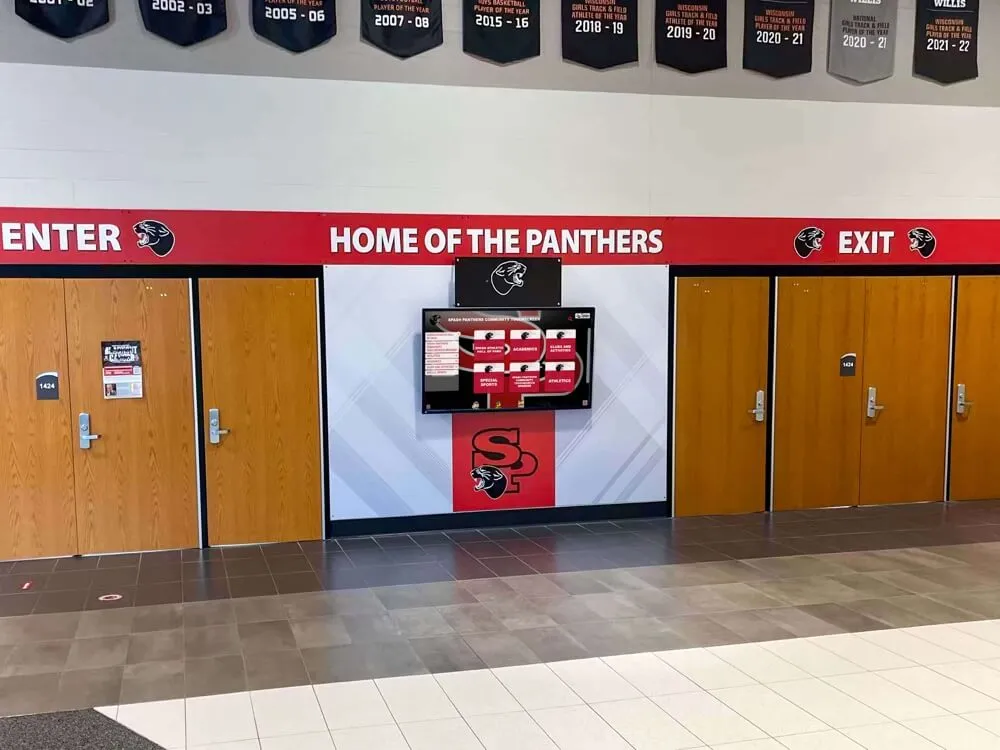
Mid-Range Recognition Systems ($5,000-$12,000)
Schools able to invest moderately can implement more sophisticated recognition with interactive capabilities:
Interactive Touchscreen Systems
Professional touchscreen displays designed specifically for recognition applications provide significantly better engagement:
- 43-55 inch commercial touchscreen: $2,500-$4,500
- Recognition-specific software platform: $800-$1,500/year
- Installation and configuration: $500-$1,000
- Content development support: $500-$1,500
- Total first-year investment: $4,300-$8,500
Purpose-built recognition platforms like those from Rocket Alumni Solutions provide templates specifically for sports records, academic honors, and student profiles—eliminating custom development costs while ensuring professional presentation.
At this price point, schools gain interactive search capabilities, unlimited content capacity, multimedia integration, and remote content management—features that transform recognition from static displays into engaging experiences students actively explore.
Hybrid Digital-Physical Displays
Combining smaller digital screens with traditional physical elements stretches budgets while maintaining visual impact:
- 32-43 inch touchscreen or digital display: $1,000-$2,500
- Custom surround design and installation: $2,000-$4,000
- Recognition software: $500-$1,000/year
- Content creation: $500-$1,500
- Total investment: $4,000-$9,000
This approach works particularly well for athletic facilities where digital screens display records and highlights while surrounding physical elements (school colors, logos, dimensional letters) create commanding presence without expensive large-format displays.
Comprehensive Recognition Programs ($12,000-$25,000)
Small schools occasionally secure special funding—facility improvement bonds, major donor gifts, booster club fundraising—enabling more substantial recognition investments:
Full-Featured Interactive Recognition Wall
Comprehensive systems provide everything larger schools have, scaled appropriately for small school needs:
- 55-65 inch commercial touchscreen: $4,000-$7,000
- Premium recognition platform (multi-year subscription): $2,000-$4,000
- Custom design and professional installation: $3,000-$6,000
- Content migration and setup: $2,000-$4,000
- Staff training and support: $1,000-$2,000
- Total investment: $12,000-$23,000
At this investment level, schools get solutions rivaling anything at larger institutions—high-resolution displays, sophisticated interactive software, professional installation, comprehensive content migration from existing recognition materials, and ongoing support ensuring long-term success.
For small schools making this level of investment, choosing recognized platforms like Rocket Alumni Solutions ensures proven reliability, extensive feature sets specifically designed for schools, and vendor stability guaranteeing long-term partnership rather than risk with unknown providers.
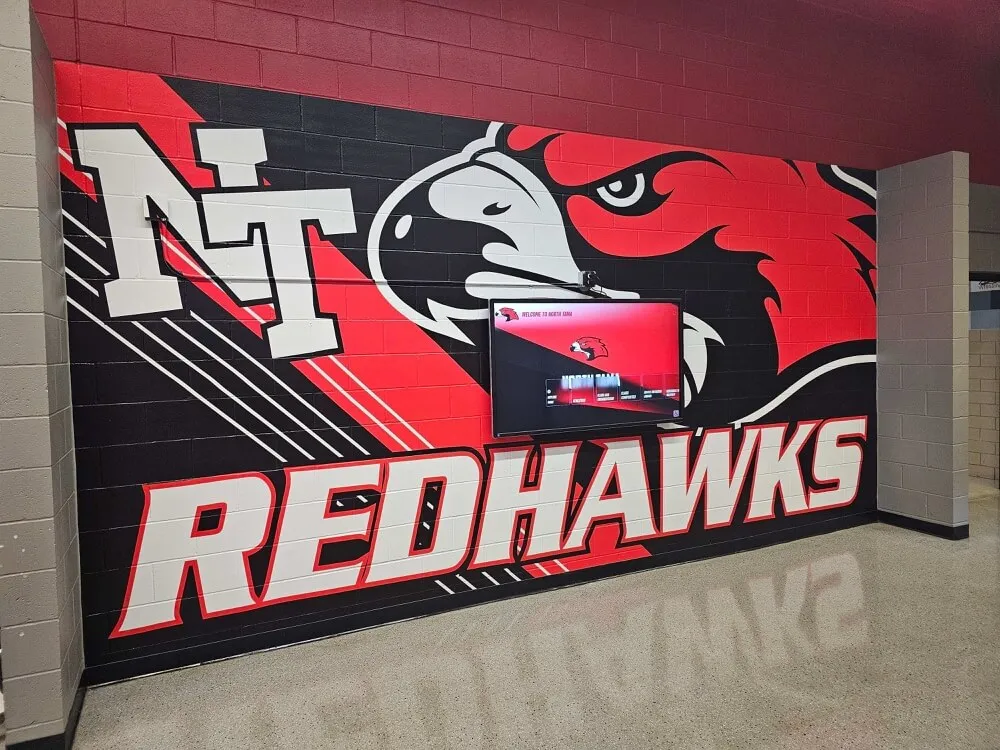
Creative Funding Strategies for Small School Recognition
Budget constraints don’t have to prevent quality recognition if schools pursue creative funding approaches:
Grant Opportunities
Several funding sources specifically support recognition and school climate initiatives:
Local Education Foundation Grants: Many communities have education foundations providing grants for projects that enhance student experience. Recognition systems supporting student motivation and school pride align well with foundation missions.
State School Improvement Grants: Various states offer competitive grants for school climate improvement, positive behavioral interventions, and student engagement initiatives—all supported by recognition programs.
Corporate Partnership Grants: Businesses often support education initiatives, particularly those involving technology integration. Recognition systems provide visible branding opportunities for corporate sponsors.
Athletics and Activities Booster Club Funding: Booster organizations frequently have resources earmarked for athlete recognition and program promotion—exactly what recognition displays provide.
Community Fundraising Campaigns
Small schools’ tight-knit communities often rally around tangible improvement projects:
Recognition Wall Naming Opportunities: Offer naming rights for recognition displays to major donors, alumni, or local businesses ($5,000-$15,000 donations).
Buy-a-Brick or Recognition Panel Programs: Traditional fundraising adapted for digital recognition—donors fund recognition of specific students, teams, or accomplishments.
Alumni Giving Campaigns: Graduates often enthusiastically support projects that would have benefited them as students, particularly recognition systems keeping alumni connected to their alma mater.
Community Business Sponsorships: Local businesses sponsor recognition displays with acknowledgment through on-screen branding, creating sustainable funding partnerships.
Multi-Year Phase Approaches
Breaking implementation into phases spreads costs across multiple budget cycles:
Year 1: Implement basic digital display with slideshow content ($2,000-$3,000) Year 2: Upgrade to interactive touchscreen ($3,000-$5,000 additional) Year 3: Add comprehensive recognition software platform ($1,000-$2,000/year) Year 4: Expand with additional displays or enhanced features ($2,000-$5,000)
This approach makes even comprehensive recognition systems achievable through sustained but manageable annual investments rather than requiring large single-year budget allocations.
Maximizing Value from Limited Recognition Budgets
Beyond finding affordable solutions, small schools can maximize recognition impact through strategic implementation approaches:
Content Strategy Optimization
Limited budgets mean schools must be strategic about content development:
Focus on Digital-Native Content: Rather than trying to digitize decades of physical trophies and plaques, focus on current and recent accomplishments where quality photos and information already exist digitally.
Leverage Student and Parent Submissions: Create simple submission forms allowing students and families to contribute photos and achievement details, crowdsourcing content development rather than requiring staff to gather everything independently.
Start with High-Impact Recognition: Begin with achievements students care most about—recent sports championships, current honor roll, this year’s awards—building content library gradually rather than attempting comprehensive historical coverage immediately.
Use Template-Based Approaches: Recognition platforms with pre-built templates eliminate custom design costs. Solutions like those from Rocket Alumni Solutions provide tested templates specifically for common recognition types schools need.
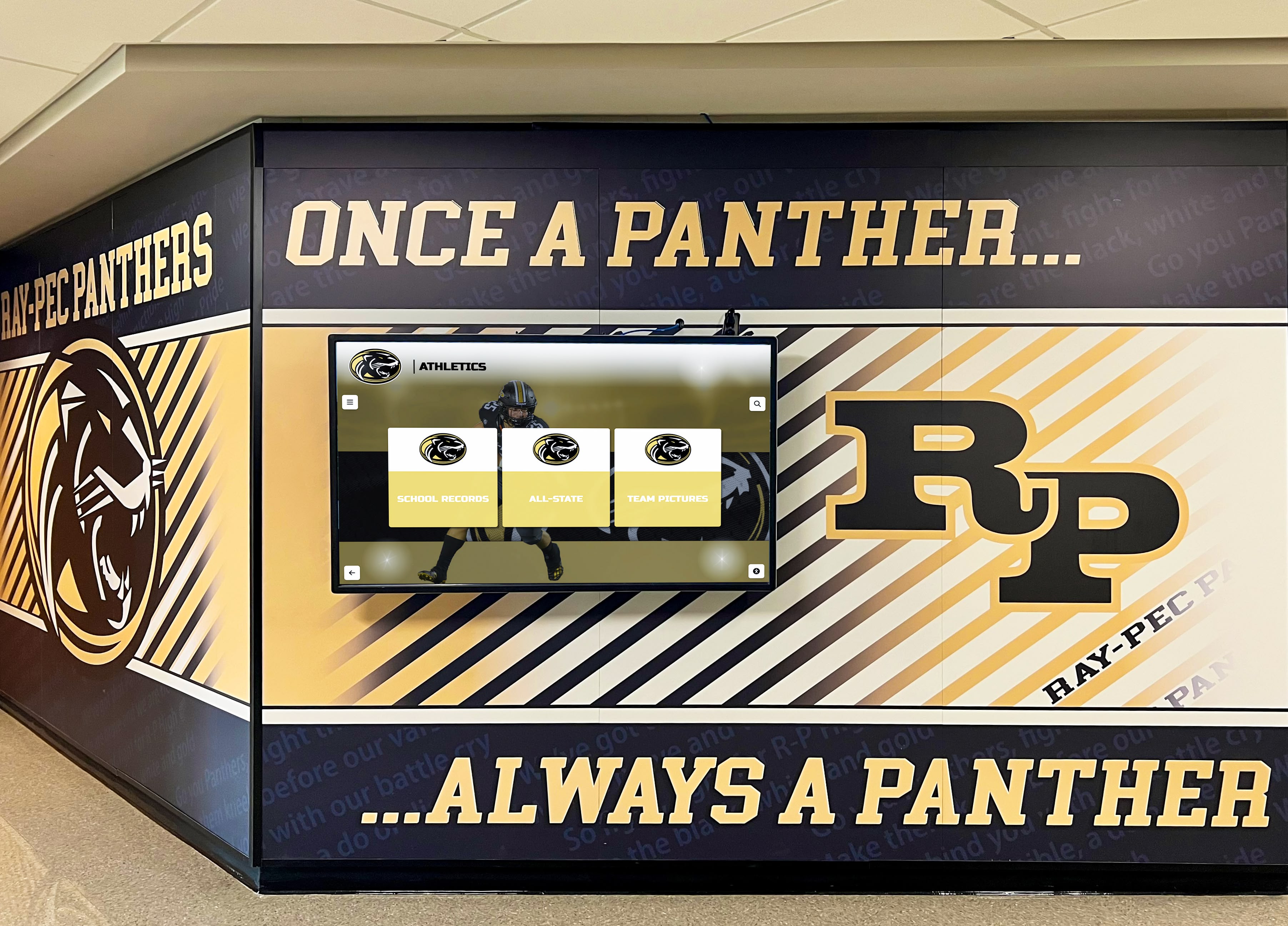
Strategic Display Placement
Location significantly impacts recognition effectiveness:
Single High-Traffic Location vs. Multiple Low-Traffic Spots: Small schools benefit more from one impressive display in a prime location (main entrance, commons area) than multiple small displays scattered throughout facilities.
Dual-Purpose Spaces: Place recognition displays where they serve multiple functions—athletic facility entrance doubles as visitor information and recognition showcase, main entrance provides recognition while highlighting school to prospective families.
Mobile Display Options: For very small schools, consider mobile display stands allowing recognition to travel between locations for special events, assemblies, and tours rather than permanent installation in single location.
Software and Platform Selection
Technology choices dramatically impact both initial and ongoing costs:
Purpose-Built Recognition Platforms vs. Generic Digital Signage: While generic digital signage software costs less initially, recognition-specific platforms like Rocket Alumni Solutions provide features schools actually need (student profiles, sports records, searchable databases) without requiring custom development costing far more than subscription price differences.
Cloud-Based vs. On-Premise Systems: Cloud platforms eliminate IT infrastructure costs and technical support requirements—critical for small schools with limited technical staff. Monthly subscription models spread costs across budget years rather than large upfront investments.
Scalability Considerations: Choose platforms that grow with schools—starting small but allowing expansion without complete replacement. Scalable systems protect initial investments as recognition programs mature.
Long-Term Cost Management
Affordable solutions must remain affordable over time:
Energy Efficiency: Commercial displays designed for continuous operation use less energy than consumer TVs while lasting longer, reducing electricity costs and replacement frequency.
Minimal Maintenance Requirements: Choose solutions with automatic software updates, remote troubleshooting, and included support—eliminating ongoing IT service costs small schools can’t afford.
Content Management Simplicity: Systems non-technical staff can manage independently avoid expensive outsourced content updates or IT department dependency.
Vendor Stability: Select established vendors with proven longevity over startups offering low prices but uncertain futures. Switching platforms after 2-3 years often costs more than paying moderate premiums for stable solutions initially.
Small School Recognition Success Stories
Understanding how similar schools implemented affordable recognition provides valuable insights:
Rural K-12 School District (250 students, $4,500 budget)
This small rural district implemented a hybrid recognition approach:
- Solution: Single 55-inch touchscreen in main hallway, basic recognition platform, student government content management
- Costs: $3,200 initial setup, $600/year software
- Funding: Local education foundation grant ($2,500) plus PTA fundraiser ($2,000)
- Results: 85% of students recognized within first year, increased student government engagement, positive community response
Key Success Factors: Starting with realistic scope focused on current students rather than attempting historical content, empowering students to manage content building ownership, choosing location maximizing daily visibility.
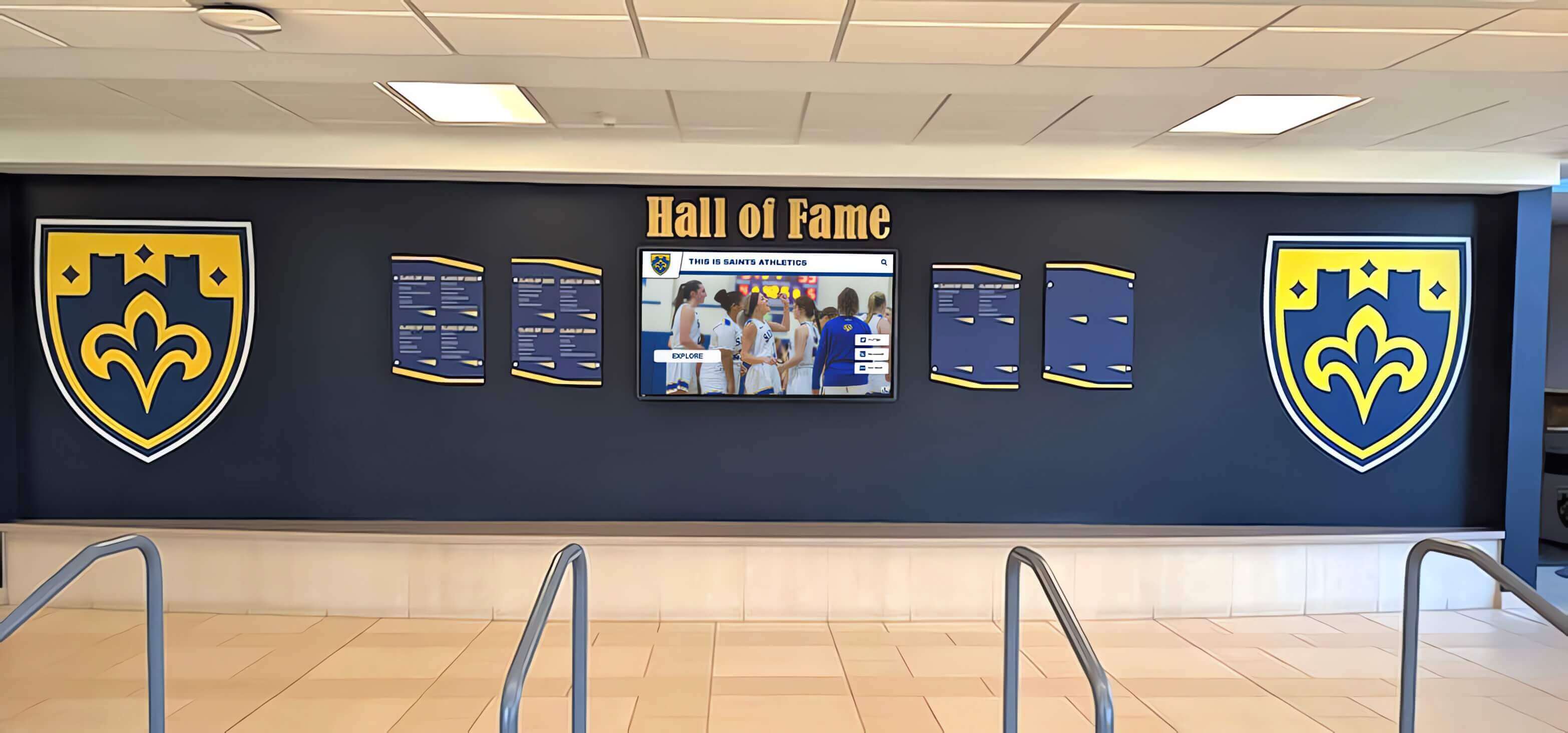
Independent Charter School (180 students, $8,000 budget)
A small charter school created comprehensive recognition on limited budget:
- Solution: 50-inch interactive touchscreen, mid-tier recognition software, phased content development
- Costs: $6,800 initial investment, $900/year software maintenance
- Funding: Designated portion of technology budget ($5,000), board fundraising campaign ($3,800)
- Results: Showcase for prospective family tours, student engagement increased 40%, donor recognition capabilities added value
Key Success Factors: Positioning recognition as recruitment and development tool justified investment, phased content approach kept initial workload manageable, professional installation ensured polished appearance appropriate for small school quality positioning.
Small Private School (120 students, $15,000 budget)
An independent school made significant recognition investment:
- Solution: 65-inch premium touchscreen, comprehensive recognition platform from Rocket Alumni Solutions, professional content migration
- Costs: $13,500 complete installation, $1,200/year platform subscription
- Funding: Major alumni donor gift ($10,000), school foundation match ($5,500)
- Results: Distinguished school showcase, historical content preservation, enhanced alumni engagement, recruitment differentiator
Key Success Factors: Secured major donor by framing as legacy project, invested in professional content migration ensuring quality historical preservation, chose premium platform ensuring long-term reliability matching school’s quality standards.
DIY vs. Professional Implementation: Making the Right Choice
Small schools must decide whether to implement recognition systems independently or invest in professional services:
When DIY Makes Sense
Do-it-yourself implementation works well when:
- Basic digital slideshow sufficient: Simple rotating content without interactivity, searchability, or sophisticated features
- Technical staff available: Someone on staff comfortable with display installation, software configuration, content creation
- Modest content requirements: Limited number of items to recognize, straightforward organization
- Time available for learning curve: Staff can invest time troubleshooting issues and learning systems
- Very limited budget: Absolutely no flexibility for professional services
When Professional Services Justify Cost
Professional implementation delivers value when:
- Interactive capabilities desired: Touchscreen navigation, searchable databases, multimedia integration require sophisticated software
- Substantial content migration: Decades of trophies, photos, and achievements to organize and digitize
- Polished presentation critical: School image and reputation depend on professional appearance
- Limited staff time: No one available to manage implementation, troubleshooting, and maintenance
- Long-term sustainability important: Professional systems with vendor support last longer with less ongoing internal effort
For most small schools, hybrid approaches work best—professional display installation and software setup with school-managed content development using platform tools.
Technology Trends Making Recognition More Affordable
Several technological developments continue improving accessibility of quality recognition:
Declining Hardware Costs
Commercial display prices have fallen dramatically:
- 2015: 55-inch commercial touchscreen cost $8,000-$12,000
- 2020: Same display cost $4,000-$6,000
- 2025: Equivalent display costs $2,500-$4,000
This trend continues, making quality hardware increasingly accessible to budget-conscious schools.
Cloud-Based Software Evolution
Cloud platforms have revolutionized affordability:
Subscription vs. Purchase Models: Rather than $10,000-$20,000 software purchases, schools pay $500-$2,000 annually—spreading costs across budget years and including ongoing updates and support.
Reduced IT Requirements: Cloud platforms work without server infrastructure, reducing initial setup costs and eliminating ongoing IT management expenses.
Automatic Updates and Improvements: Schools continuously receive software enhancements and new features without additional costs or technical complexity.
Recognition-Specific Platforms
Purpose-built school recognition platforms eliminate custom development:
Solutions like digital record boards and interactive kiosk software provide exactly what schools need without paying for unnecessary features or requiring expensive customization.
Mobile and Web Integration
Modern recognition platforms extend beyond physical displays:
Web-Based Access: Content appears both on campus touchscreens and school websites, maximizing value from single content investment.
Mobile Apps: Some platforms provide mobile applications, further extending recognition reach without additional costs.
Social Media Integration: Automated posting capabilities spread recognition across platforms schools already use, multiplying impact without multiplying work.
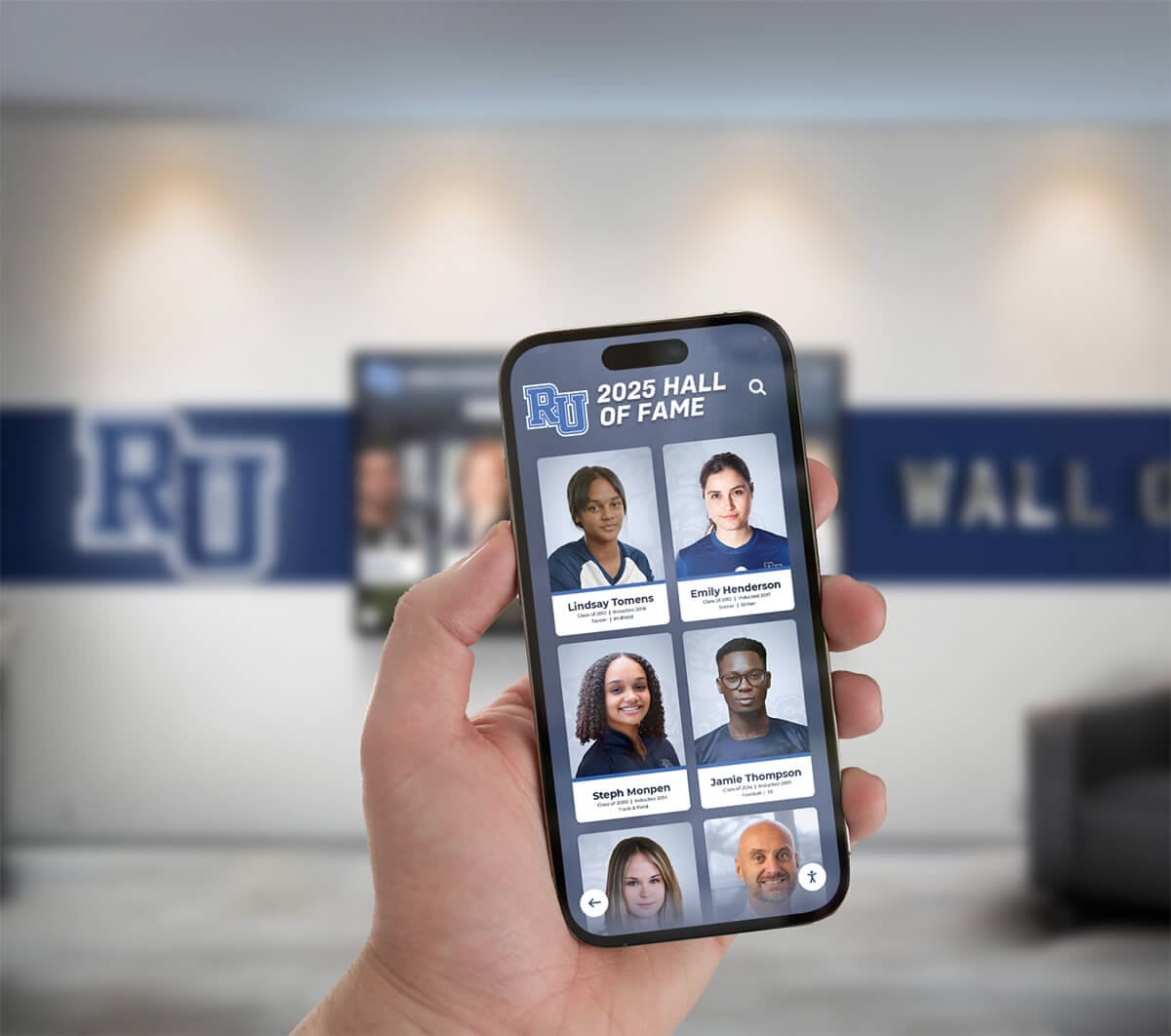
Maintaining Affordable Recognition Long-Term
Initial affordability matters little if ongoing costs become unsustainable:
Content Management Sustainability
Recognition programs fail when content management becomes overwhelming:
Distributed Content Creation: Rather than single-person bottlenecks, empower coaches, teachers, and student leaders to submit achievements using simple forms—spreading workload across many people.
Student Involvement: Student government, leadership classes, or technology clubs can manage routine content updates, building student ownership while reducing staff burden.
Seasonal Update Cycles: Quarterly or trimester updates prove more sustainable than attempting real-time recognition requiring constant attention.
Template-Based Content Creation: Platforms providing content templates dramatically reduce time required for each new recognition item, making regular updates feasible.
Technical Maintenance Considerations
Ongoing technical requirements impact affordability:
Vendor-Managed Software: Cloud platforms maintained by vendors eliminate IT staff involvement in updates, patches, and troubleshooting.
Commercial Display Reliability: While costing more initially, commercial displays last 50,000+ hours versus 20,000-30,000 hours for consumer TVs—fewer replacements over time.
Remote Management Capabilities: Platforms allowing remote content updates and display monitoring reduce need for on-site technical interventions.
Warranty and Support Inclusion: Comprehensive warranties and included support prevent unexpected costs when issues arise.
Budget-Friendly Expansion Strategies
Successful initial recognition often leads to expansion requests:
Modular Growth: Choose platforms allowing additional displays to be added over time, reusing software investments and content libraries.
Phased Feature Addition: Start with basic features, adding advanced capabilities (video integration, mobile apps, additional content categories) as budget allows.
Alternative Funding for Expansion: Once initial value is proven, expansions often attract funding from sources that wouldn’t have supported unproven initial implementations.
Making Your Affordable Recognition Decision
For small schools evaluating recognition options, structured decision-making ensures wise investments:
Assessment Questions to Answer First
Before comparing vendors or specific solutions, clarify needs and constraints:
- What’s our realistic total budget? (Include initial investment AND ongoing costs)
- What recognition types matter most? (Athletics, academics, arts, all-school achievements)
- What level of interactivity do we need? (Simple display vs. touchscreen exploration)
- Who will manage content updates? (Ensure whoever selected understands commitment)
- What’s our timeline? (Immediate need vs. flexible multi-year implementation)
- What funding sources might we access? (Operating budget, grants, donors, fundraising)
- How important is vendor support? (DIY tolerance vs. need for ongoing assistance)
Comparison Criteria for Solution Evaluation
When evaluating specific options, assess:
Total Cost of Ownership: Initial investment + 3-year software/support costs + estimated content development time
Feature Fit: Does solution provide specifically what you need without paying for unnecessary sophistication OR lacking critical capabilities
Ease of Management: Can your actual staff (not idealized technical person) maintain content independently
Vendor Stability: Will this company exist in 5 years to support your investment
Scalability: Can solution grow if recognition programs expand or funding improves
Reference Checks: Talk to schools similar to yours using the solution—not cherry-picked success stories but schools facing similar constraints
Implementation Readiness Assessment
Ensure organizational readiness before committing:
- Stakeholder Buy-In: Do principals, coaches, teachers, and students support recognition priorities
- Content Availability: Do you have photos, achievement details, or systems to gather them
- Process Definition: Have you defined who submits content, who approves it, who publishes it
- Success Metrics: How will you measure whether recognition investment delivers value
- Contingency Plans: What happens if initial approaches don’t work as expected
Resources for Small School Recognition Success
Small schools benefit from leveraging existing resources rather than starting from scratch:
Educational Organization Resources
Professional associations provide recognition guidance:
- National Association of Secondary School Principals (NASSP): School climate and student engagement resources
- State Athletic Associations: Often provide recognition standards and shared resources
- Educational Service Centers: Regional centers frequently offer technology purchasing cooperatives and implementation support
Technology Platform Evaluation Resources
Independent comparison resources help evaluate options:
- EdTech comparison sites: Objective reviews of digital signage and recognition platforms
- School technology forums: Other administrators’ experiences with specific solutions
- State technology consortiums: Bulk purchasing opportunities and vetted vendor lists
Funding Research Resources
Various sources help identify recognition funding:
- Grant databases for education technology: Searchable grants supporting technology and student engagement
- Corporate foundation directories: Companies supporting education initiatives in your region
- State education agency funding opportunities: Competitive and formula grants potentially supporting recognition
- Local community foundation grants: Geographic-specific funding for school improvement projects
Conclusion: Quality Recognition Is Achievable on Any Budget
Small schools face real financial constraints, but those constraints don’t have to mean students receive inferior recognition compared to larger, wealthier institutions. With strategic planning, creative funding approaches, and smart technology choices, schools can implement recognition systems that rival anything larger schools offer.
The key lies in understanding that “affordable” doesn’t mean “cheap”—it means choosing solutions that deliver maximum value relative to investment. A $3,000 system that sustainably recognizes every student accomplishment for years delivers better value than a $20,000 system that’s too complex to maintain or too limited to serve actual recognition needs.
Modern technology has democratized access to professional recognition solutions. Cloud-based software, declining hardware costs, and purpose-built school platforms from providers like Rocket Alumni Solutions mean small schools can implement sophisticated interactive digital displays at price points that once seemed impossible.
Your students accomplish remarkable things despite attending small schools with limited budgets. They deserve recognition that honors those accomplishments appropriately. With the strategies, options, and resources outlined in this guide, you can create recognition programs that celebrate every achievement, build school pride, and demonstrate your institutional commitment to student success—all within budgets small schools can afford.
Ready to explore affordable recognition solutions for your small school? Start by defining your specific needs and constraints, research options matching your situation, and reach out to vendors specializing in small school implementations. Quality recognition is within reach—your students are worth the investment.



































